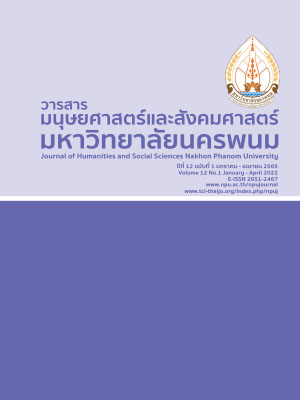The Cost-effectiveness of Treatment and Rehabilitation for Juvenile Offenders: A case study Juvenile Vocational Training Center
Main Article Content
Abstract
This research aims to evaluate the working performance’s effectiveness of the Juvenile Vocational Training Center. Seventeen centers where the samplings were recruited by in the secondary data, totaling 680 samples, monthly data between September 2016 and December 2019. This research was a mixed method. The cost-effectiveness analysis applied an incremental cost-effectiveness ratio for the quantitative research. In addition, eight key informants included both executives and experienced operators. They were participating in a focus group. The qualitative data was included content analysis and interpretative techniques. The results presented that there were about 4,263 youths in a year receiving courses of corrections, therapy and rehabilitation. “Training center E” was effective in its management and functions in delivering low-cost remedial therapy to youth group. The unit cost of center E is 15,000 Bath per month. There was 3.52% of cost reduction from effective management and rehabilitation whereas the number of re-offenders is decreasing. The authority should offer sufficient budget and develop a team-oriented resource management system to reduce the cost of centers in the long run.
Article Details

This work is licensed under a Creative Commons Attribution-NonCommercial-NoDerivatives 4.0 International License.
References
Chantith, C., Permpoonwiwat, C. K., and Fowles, R. (2021). Cost-Effectiveness of Road Safety Policy for Preventing and Reducing Road Traffic Fatalities in Thailand. Thailand and The World Economy, 39(1), 1-17.
Department of Juvenile Observation and Protection. (2013). khūmư̄ kānnam prōkrǣm pai chai prōkrǣm kǣkhai bambat læ fư̄nfū khō̜ng sūn fưk læ ʻoprom dek læ yaowachon [Program Manual for the Corrective, Therapy and Rehabilitation Program of the Child and Youth Training Center].Bangkok: Department of Juvenile Observation and Protection.
Department of Juvenile Observation and Protection. (2019). kān patibat tō̜ dek læ yaowachon tām māttrathān khō̜ng ʻOngkān Sahaprachāchāt [Standards of Treatment of Children and Youth by the United Nations]. Retrieved October 2019, from http://www.djop.go.th/images/djopimage/info25.jpg
Department of Juvenile Observation and Protection. (2020a). Rāingān kān dā nœ̄n ngān khō̜ng rat tō̜ sāthārana rāi pī pračham pīngoppramān Phō̜.Sō̜. [Department of Juvenile Observation and Protection Annual 2019]. Bangkok: Department of Juvenile Observation and Protection.
Department of Juvenile Observation and Protection. (2020b). Khō̜mūn khō̜ng dek læ yaowachon thī kratham phit sam yǣk tām rāi sūn fưk læ ʻoprom dek læ yaowachon pī. [Juvenile Recidivism Statistic Annual Report 2019]. Bangkok: Department of Juvenile Observation and Protection.
Fried, H. O., Lovell, C. A. K., and Schmidt, S. S. (2008). The Measurement of Productive Efficiency and Productivity Growth. New York: Oxford university press, Inc.
Lev-Wiesel, R., Massrawa, N., and Binson, B. (2020). Parents’ and Children’s Perceptions of Child Maltreatment. Journal of Social Work, 20(4), 395-410.
Kittawetin, A. (2008). māttrathān kāndamnœ̄n ngān læ kān patibat tō̜ dek læ yaowachon thī kratham phit khō̜ng krom phinit læ khumkhrō̜ngdek læ yaowachon [Standards of Operations and Treatment of Offending Children and Youth of the Department of Juvenile Observation and Protection]. Bangkok: Department of Juvenile Observation and Protection.
McIntosh, C., and Li, J. (2012). An Introduction to Economic Analysis in Crime Prevention: The Why, How and So What. Ottawa: National Crime Prevention Centre.
Mitchell, D., Tafrate, R.C., and Hogan, T. (2018). Cognitive Behavioral Therapy in Forensic Treatment. In: Jeglic E., Calkins C. (eds) New Frontiers in Offender Treatment. Cham: Springer.
National Statistical Office. (2019). Sathiti rāidai læ rāičhāi khō̜ng khrūarư̄an. [The 2019 Household Socio-Economic Survey Whole Kingdom]. Bangkok: National Statistical Office.
Neumann, P.J., and Sanders, G.D. (2017). Cost-Effectiveness Analysis 2.0. The New England Journal of Medicine, 376(3), 203-205.
Sabaijai, T. K., and Pathumcharoenwattana, W. (2019). Kānphatthanā rabop sanapsanun læ sœ̄msāng sakkayaphāp dek læ yaowachon nai krabūankān yuttham bǣp mī sūan rūam. [The Education System Development of Juvenile Offender A case study Juvenile Vocational Training Center Center]. Bangkok: Thailand Research Fund.
Sinloyma, P. (2017). Kān plīanplǣng krabūan that khō̜ng dek læ yaowachon Thai thī krathā phit sam phư̄a sœ̄msāng khwām tranak nai khunkhā khō̜ng chīwit kō̜n khư̄n sū sangkhom. [The Paradigm-ship of Juvenile Recidivism A case study Juvenile Vocational Training Center]. Bangkok: Thailand Research Fund.
Suntigul, P. (2017). Cost-Benefit Analysis of Uninterrupted Tailor-made Routing Project. Journal of politics, administration and law, 9(3), 613-643.
The Michigan Council on Crime and Delinquency (2011). Michigan Youth Reentry Model Building a Reentry Framework for Youth, Families and Communities. Michiga: The Michigan Committee on Juvenile Justice and the Office of Juvenile Justice and Delinquency Prevention.
Turner, H. C., Toor, J., Hollingsworth, T. D., and Anderson, R. M. (2018). Economic Evaluations of Mass Drug Administration: The Importance of Economies of Scale and Scope. Clinical Infectious Diseases, 66(8), 1298-1303.


